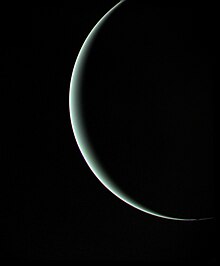
Back استكشاف أورانوس Arabic Изследване на Уран Bulgarian Exploració d'Urà Catalan Exploración de Urano Spanish اکتشاف اورانوس Persian Exploration du système uranien French Penjelajahan Uranus ID Esplorazione di Urano Italian 天王星探査 Japanese ಯುರೇನಸ್ ಗ್ರಹದ ಅನ್ವೇಷಣೆ Kannada

The exploration of Uranus has, to date, been through telescopes and a lone probe by NASA's Voyager 2 spacecraft, which made its closest approach to Uranus on January 24, 1986. Voyager 2 discovered 10 moons, studied the planet's cold atmosphere, and examined its ring system, discovering two new rings. It also imaged Uranus' five large moons, revealing that their surfaces are covered with impact craters and canyons.
A number of dedicated exploratory missions to Uranus have been proposed,[1][2] but as of 2023[update] none have been approved.[3][4]
- ^ "Revisiting the ice giants: NASA study considers Uranus and Neptune missions". Planetary Society. 21 June 2017. Retrieved 24 June 2017.
- ^ "Ice Giant Mission Study Final Report". NASA / Lunar and Planetary Institute. June 2017. Retrieved 25 June 2017.
- ^ Cite error: The named reference
Uran1was invoked but never defined (see the help page). - ^ Cite error: The named reference
Uran2was invoked but never defined (see the help page).